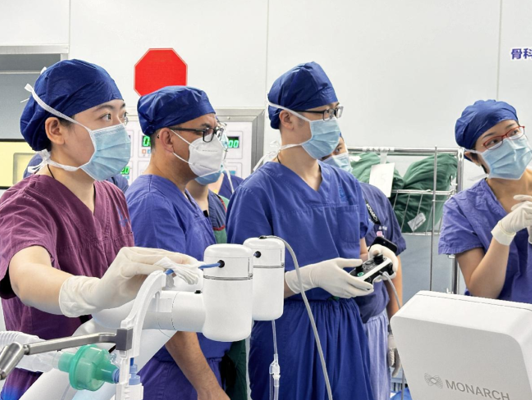- News
Non-invasive Biopsy and Surgical Localization of Lung Lesions Now Possible! Shanghai's First Case in Shanghai General Hospital: Monarch Robotic Bronchoscopy-Assisted Sub-lobar Resection
无创完成肺部病变活检及手术定位成为可能!沪上首例:Monarch机器人气管镜技术辅助下切除亚肺叶

With the widespread use of CT screening for lung cancer, early detection of pulmonary nodules has become increasingly common. Currently, most preoperative localizations of lesions requiring surgery are performed using CT-guided percutaneous puncture, which carries the risk of complications and can cause discomfort for some patients. Recently, non-invasive biopsy and surgical localization of lung lesions have become a reality. The Thoracic Surgery Department at Shanghai General Hospital has taken the lead in utilizing Monarch robotic bronchoscopy technology for precise localization of a lung lesion in a patient, marking the first case of its kind in Shanghai. The Thoracic Surgery Department at Shanghai General Hospital has announced plans to further enhance its capabilities in non-invasive, painless localization and biopsy techniques. In the future, robotic bronchoscopy is expected to play an even more significant role in the diagnosis and treatment of lung diseases.

The patient who underwent the procedure was a female who had been hospitalized for three months after discovering a pulmonary nodule. Upon examination, a 10mm ground-glass nodule was found in her left upper lung, suspected to be high-risk.Localizing and characterizing such nodules during thoracoscopic surgery is notoriously difficult. These nodules are often located deep within the lung, are small in size, or exhibit subsolid characteristics. Additionally, these nodules do not alter the surface of the visceral pleura and are difficult to palpate due to the small incisions used in thoracoscopic surgery.
How can accurate localization of lung lesions be achieved for these patients using minimally invasive or even non-invasive techniques? This is a question that the medical community has been striving to answer.
The Thoracic Surgery team at Shanghai General Hospital, led by Professor Fan Jiang, has pioneered a new approach: utilizing the Monarch robotic bronchoscopy system for precise, painless preoperative localization. The robotic bronchoscopy system integrates multimodal navigation through optical recognition, dynamic electromagnetic guidance, and bronchoscopic motion, allowing non-invasive access to deep lung lesions through natural airways. This innovation not only improves the diagnostic accuracy for peripheral lung lesions but also enables "non-invasive diagnosis."
To ensure the success of the procedure, the thoracic surgery team conducted comprehensive preoperative planning and surgical pathway analysis. They also invited Professor Raed Alnajja, an expert in the field, to Shanghai General Hospital for consultation and guidance.

On the day of the surgery, Dr. Zou Yun from the Department of Anesthesiology, under the leadership of Director Dr. Li Jinbo, provided anesthesia support for the operation. Under the guidance of Professor Fan Jiang and Professor Raed Alnajja, Associate Chief Physician Dr. Yang Fu operated the robotic bronchoscope to precisely localize the lesion. With real-time visualization, the puncture needle followed the pre-planned path through the bronchial branches to the lung lesion, where dye was injected for accurate localization. Following this, the surgical team successfully performed a sub-lobar resection using single-port thoracoscopic surgery.
